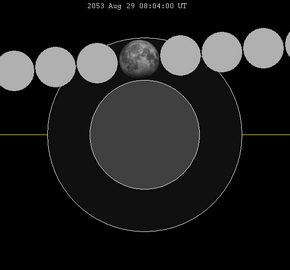August 2053 lunar eclipse
| Penumbral eclipse | |||||||||
 The Moon's hourly motion shown right to left | |||||||||
| Date | August 29, 2053 | ||||||||
|---|---|---|---|---|---|---|---|---|---|
| Gamma | 1.0165 | ||||||||
| Magnitude | −0.0319 | ||||||||
| Saros cycle | 119 (64 of 83) | ||||||||
| Penumbral | 277 minutes, 51 seconds | ||||||||
| |||||||||
A penumbral lunar eclipse will occur at the Moon’s descending node of orbit on Friday, August 29, 2053,[1] with an umbral magnitude of −0.0319. It will be a relatively rare total penumbral lunar eclipse, with the Moon passing entirely within the penumbral shadow without entering the darker umbral shadow.[2] A lunar eclipse occurs when the Moon moves into the Earth's shadow, causing the Moon to be darkened. A penumbral lunar eclipse occurs when part or all of the Moon's near side passes into the Earth's penumbra. Unlike a solar eclipse, which can only be viewed from a relatively small area of the world, a lunar eclipse may be viewed from anywhere on the night side of Earth. Occurring about 4.7 days after apogee (on August 24, 2053, at 14:30 UTC), the Moon's apparent diameter will be smaller.[3]
Visibility
[edit]The eclipse will be completely visible over much of North America and western South America, seen rising over northeast Asia and Australia and setting over eastern South America and west Africa.[4]
Eclipse details
[edit]Shown below is a table displaying details about this particular solar eclipse. It describes various parameters pertaining to this eclipse.[5]
| Parameter | Value |
|---|---|
| Penumbral Magnitude | 1.02028 |
| Umbral Magnitude | −0.03187 |
| Gamma | 1.01651 |
| Sun Right Ascension | 10h32m52.4s |
| Sun Declination | +09°08'07.1" |
| Sun Semi-Diameter | 15'50.2" |
| Sun Equatorial Horizontal Parallax | 08.7" |
| Moon Right Ascension | 22h31m49.7s |
| Moon Declination | -08°14'09.0" |
| Moon Semi-Diameter | 15'03.1" |
| Moon Equatorial Horizontal Parallax | 0°55'14.5" |
| ΔT | 87.5 s |
Eclipse season
[edit]This eclipse is part of an eclipse season, a period, roughly every six months, when eclipses occur. Only two (or occasionally three) eclipse seasons occur each year, and each season lasts about 35 days and repeats just short of six months (173 days) later; thus two full eclipse seasons always occur each year. Either two or three eclipses happen each eclipse season. In the sequence below, each eclipse is separated by a fortnight.
| August 29 Descending node (full moon) |
September 12 Ascending node (new moon) |
|---|---|
 |

|
| Penumbral lunar eclipse Lunar Saros 119 |
Total solar eclipse Solar Saros 145 |
Related eclipses
[edit]Eclipses in 2053
[edit]- A penumbral lunar eclipse on March 4.
- An annular solar eclipse on March 20.
- A penumbral lunar eclipse on August 29.
- A total solar eclipse on September 12.
Metonic
[edit]- Preceded by: Lunar eclipse of November 9, 2049
- Followed by: Lunar eclipse of June 17, 2057
Tzolkinex
[edit]- Preceded by: Lunar eclipse of July 18, 2046
- Followed by: Lunar eclipse of October 9, 2060
Half-Saros
[edit]- Preceded by: Solar eclipse of August 23, 2044
- Followed by: Solar eclipse of September 3, 2062
Tritos
[edit]- Preceded by: Lunar eclipse of September 29, 2042
- Followed by: Lunar eclipse of July 28, 2064
Lunar Saros 119
[edit]- Preceded by: Lunar eclipse of August 19, 2035
- Followed by: Lunar eclipse of September 9, 2071
Inex
[edit]- Preceded by: Lunar eclipse of September 18, 2024
- Followed by: Lunar eclipse of August 8, 2082
Triad
[edit]- Preceded by: Lunar eclipse of October 29, 1966
- Followed by: Lunar eclipse of June 30, 2140
Lunar eclipses of 2053–2056
[edit]| Ascending node | Descending node | |||||
|---|---|---|---|---|---|---|
| Saros | Date Viewing |
Type Chart |
Saros | Date Viewing |
Type Chart | |
| 114 | 2053 Mar 04
|
Penumbral
|
119 | 2053 Aug 29 |
Penumbral
| |
| 124 | 2054 Feb 22
|
Total
|
129 | 2054 Aug 18
|
Total
| |
| 134 | 2055 Feb 11
|
Total
|
139 | 2055 Aug 07
|
Partial
| |
| 144 | 2056 Feb 01
|
Penumbral
|
149 | 2056 Jul 26
|
Partial
| |
| Last set | 2052 Apr 14 | Last set | 2052 Oct 08 | |||
| Next set | 2056 Dec 22 | Next set | 2056 Jun 27 | |||
Half-Saros cycle
[edit]A lunar eclipse will be preceded and followed by solar eclipses by 9 years and 5.5 days (a half saros).[6] This lunar eclipse is related to two solar eclipses of Solar Saros 126.
| August 23, 2044 | September 3, 2062 |
|---|---|

|

|
See also
[edit]References
[edit]- ^ "August 28–29, 2053 Penumbral Lunar Eclipse". timeanddate. Retrieved 12 December 2024.
- ^ Total Penumbral Lunar Eclipses, Jean Meeus, June 1980
- ^ "Moon Distances for London, United Kingdom, England". timeanddate. Retrieved 12 December 2024.
- ^ "Partial Lunar Eclipse of 2053 Aug 29" (PDF). NASA. Retrieved 12 December 2024.
- ^ "Penumbral Lunar Eclipse of 2053 Aug 29". EclipseWise.com. Retrieved 12 December 2024.
- ^ Mathematical Astronomy Morsels, Jean Meeus, p.110, Chapter 18, The half-saros
External links
[edit]- 2053 Aug 29 chart Eclipse Predictions by Fred Espenak, NASA/GSFC



